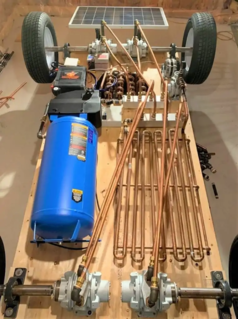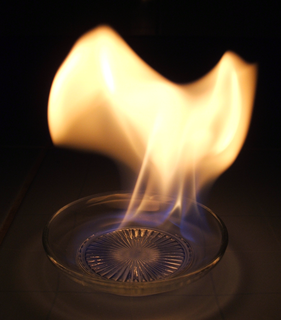
The Honda Insight is a hybrid electric vehicle that is manufactured and marketed by Honda. Its first generation was a two-door, two passenger liftback (1999–2006) and in its second generation was a four-door, five passenger liftback (2009–2014). In its third generation, it became a four-door sedan (2019–present). It was Honda's first model with Integrated Motor Assist system and the most fuel efficient gasoline-powered car available in the U.S. without plug-in capability — for the length of its production run.

A compressed-air vehicle (CAV) is a transport mechanism fueled by tanks of pressurized atmospheric gas and propelled by the release and expansion of the gas within a Pneumatic motor.

The Ford C-Max is a compact multi-purpose vehicle (MPV) produced by the Ford Motor Company from 2003 to 2019. The Ford Grand C-Max has a longer wheelbase.

The Honda K-series engine is a line of four-cylinder four-stroke car engine introduced in 2001. The K-series engines are equipped with DOHC valvetrains and use roller rockers on the cylinder head to reduce friction. The engines use a coil-on-plug, distributorless ignition system with a coil for each spark plug. This system forgoes the use of a conventional distributor-based ignition timing system in favor of a computer-controlled system that allows the ECU to control ignition timings based on various sensor inputs. The cylinders have cast iron sleeves similar to the B- and F-series engines, as opposed to the FRM cylinders found in the H- and newer F-series engines found only in the Honda S2000.
Shell Eco-marathon is a world-wide energy efficiency competition sponsored by Shell. Participants build automotive vehicles to achieve the highest possible fuel efficiency. There are two vehicle classes within Shell Eco-marathon: Prototype and UrbanConcept. There are three energy categories within Shell Eco-marathon: battery-electric, hydrogen fuel cell, and internal combustion engine. Prizes are awarded separately for each vehicle class and energy category. The pinnacle of the competition is the Shell Eco-marathon Drivers' World Championship, where the most energy-efficient UrbanConcept vehicles compete in a race with a limited amount of energy.

Various alcohols are used as fuel for internal combustion engines. The first four aliphatic alcohols are of interest as fuels because they can be synthesized chemically or biologically, and they have characteristics which allow them to be used in internal combustion engines. The general chemical formula for alcohol fuel is CnH2n+1OH.

The Mercedes-Benz C-Class (W204) is the third generation of the Mercedes-Benz C-Class. It was manufactured and marketed by Mercedes-Benz in sedan/saloon (2007–2014), station wagon/estate (2008–2014) and coupé (2011–2015) bodystyles, with styling by Karlheinz Bauer and Peter Pfeiffer.
SmILE is a showcase car designed for Greenpeace in 1996 to demonstrate how fuel efficient a car can be. The name stands for "Small, Intelligent, Light, Efficient'. It is based on the Renault Twingo, halving its fuel consumption to 3.3 l/100km.

Eco-Runner Team Delft is a Delft University of Technology student team, aiming to promote a sustainable future by building the world's most efficient hydrogen-powered car. At the end of the year, the team participates in the Shell Eco-marathon competition in order to assess the efficiency of the vehicle. In the competition there are two vehicle classes: Prototype and UrbanConcept. For years Eco-Runner Team Delft participated in the Shell Eco-marathon Prototype class competition where the goal is to cover a certain distance with the least amount of hydrogen. In the year 2019-2020, the team has decided to compete in a different competition; the Urban Concept class. This challenge offers the team the opportunity to design and build an efficient hydrogen-powered vehicle that is closer in appearance to modern city cars.
S-AWC is the brand name of an advanced full-time four-wheel drive system developed by Mitsubishi Motors. The technology, specifically developed for the new 2007 Lancer Evolution, the 2010 Outlander, the 2014 Outlander, the Outlander PHEV and the Eclipse Cross have an advanced version of Mitsubishi Motors' AWC system. Mitsubishi Motors first exhibited S-AWC integration control technology in the Concept-X model at the 39th Tokyo Motor Show in 2005. According to Mitsubishi Motors, "the ultimate embodiment of the company's AWC philosophy is the S-AWC system, a 4WD-based integrated vehicle dynamics control system".
OBDuino is an open source trip computer design based on the Arduino platform. An OBDuino may be assembled and customised by an electronics hobbyist; it displays information such as instantaneous fuel economy, engine tuning parameters etc. on an LCD.
The DNV Fuel Fighter is a battery electric car that was designed and built in Norway as a student project at the Norwegian University of Science and Technology (NTNU). It was built to compete in the Shell Eco Marathon. The purpose of the competition is to design a vehicle that can drive as far as possible on the least amount of fuel.

The Mitsubishi Lancer WRC is a World Rally Car built by Ralliart, Mitsubishi Motors' motorsport division, to compete in the World Rally Championship. The previous Lancer Evolution series were homologated for the Group A class, and their competitiveness against World Rally Cars from other manufacturers was therefore limited.
The Mizzou Hydrogen Car Team designs, builds and competes with an Urban Concept hydrogen fuel cell vehicle run by students at the University of Missouri in Columbia, Missouri. They recently competed with their vehicle named "Tigergen III" in the 2013 Shell Eco-Marathon. At the competition they achieved 8.8 mi/kWh which placed them 3rd in the UrbanConcept Hydrogen category. The team also won an off-track award for "Best Team Spirit"
DTU Roadrunners is a student driven project at the Technical University of Denmark competing in the Shell Eco-marathon races. The team participates in one or both of the two classes at Shell Eco-Marathon Europe: the UrbanConcept class and the Prototype class with the cars Dynamo and Innovator respectively. The team consists of 20 to 30 students. Project work in the course is based on the CDIO-working form and students are thus responsible for the development, construction and operation of the vehicles.
The Dynamo 9.0 is the ninth-generation car run by DTU Roadrunners to compete in the Urban Concept class in the Shell Eco-marathon Europe. As same as the previous generation of Urban Concept cars developed by students at the Technical University of Denmark, it has the single purpose of achieving the best fuel economy as possible. The Dynamo 9.0 is the current workhorse of the DTU Roadrunners for the said competition.
Biofuels play a major part in the renewable energy strategy of Denmark. Denmark is using biofuel to achieve its target of using 100% renewable energy for all energy uses by 2050. Biofuels provide a large share of energy sources in Denmark when considering all sectors of energy demand. In conjunction with Denmark's highly developed renewable energy resources in other areas, biofuels are helping Denmark meet its ambitious renewable energy targets.

The Daihatsu Mira e:S is a kei car manufactured by the Japanese automaker Daihatsu as the successor to the original Mira. It was previewed by the "e:S" concept car at the 2009 Tokyo Motor Show. The car was introduced to the Japanese market in September 2011. It was also sold by Toyota as the Toyota Pixis Epoch, which was released on 10 May 2012 and by Subaru as the Subaru Pleo Plus, which was released on 21 December 2012.
The Duke Electric Vehicles (DEV) team is composed of undergraduates at Duke University's Pratt School of Engineering. The team designs, builds, and competes with a manned, electrically powered supermileage vehicle each year. The team was founded in 2011 and has competed in the Shell Eco-Marathon Americas for 7 years. On July 21, 2018, their hydrogen fuel cell vehicle, "Maxwell", achieved the world record for the most fuel efficient prototype vehicle with a fuel efficiency of 14,573 MPGe, previously set in 2005 by ETH Zurich's Pac-car II at 12,600 MPGe.

The Dallara T08 was a racing car developed by Italian manufacturer Dallara for use in the Formula Renault 3.5 series, and was in use from 2008 to 2011. The T08 is the second generation of car used by the World Series by Renault/WS Formula V8 3.5, and was introduced at Circuit de Nevers Magny-Cours. The carbon tub of the car would later be carried over to its successor, the Dallara T12.










